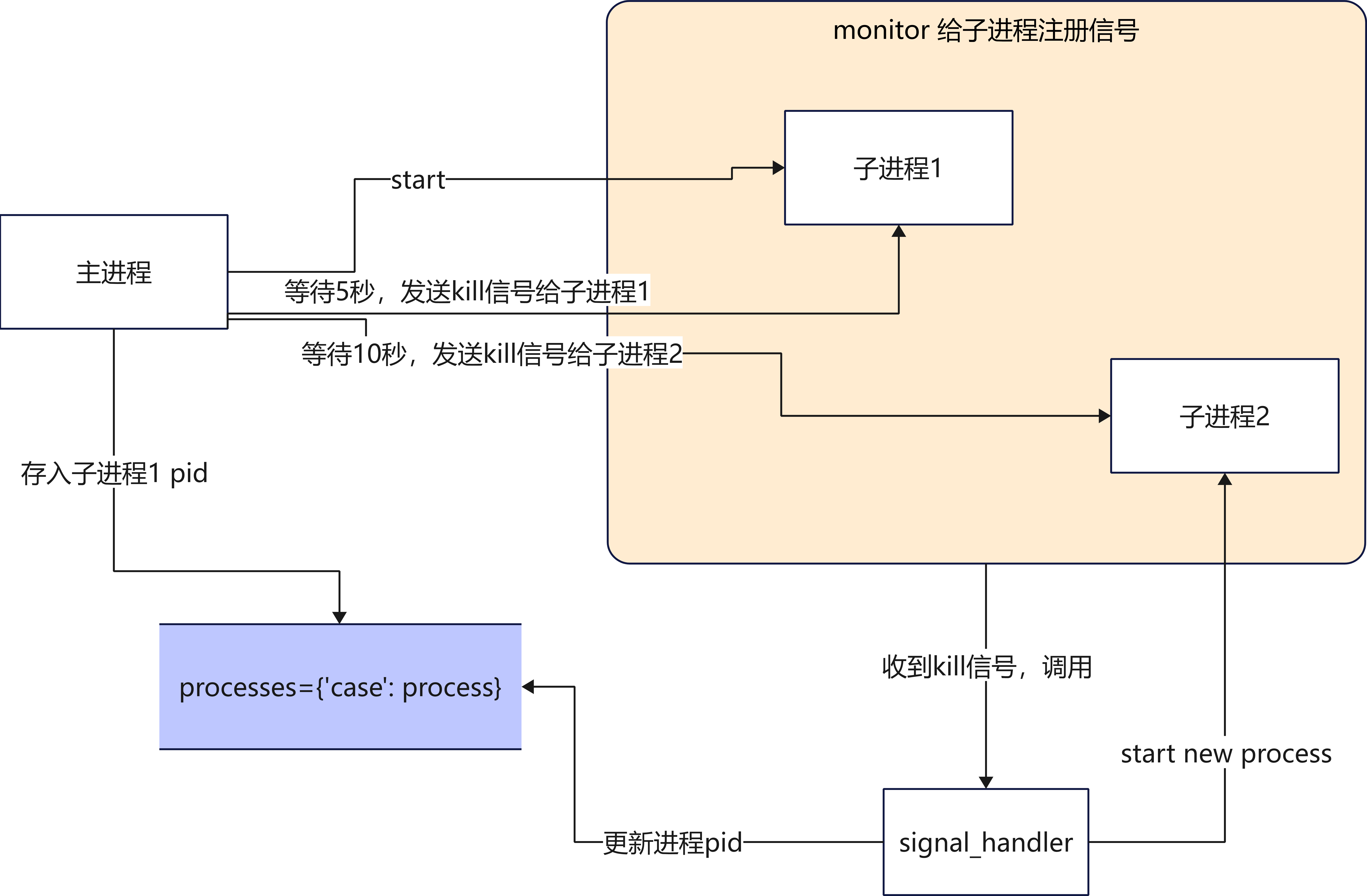如何用Python实现配置热加载?
背景
由于最近工作需求,需要在已有项目添加一个新功能,实现配置热加载的功能。所谓的配置热加载,也就是说当服务收到配置更新消息之后,我们不用重启服务就可以使用最新的配置去执行任务。
如何实现
下面我分别采用多进程、多线程、协程的方式去实现配置热加载。
使用多进程实现配置热加载
如果我们代码实现上使用多进程, 主进程1来更新配置并发送指令,任务的调用是进程2,如何实现配置热加载呢?
使用signal信号量来实现热加载

当主进程收到配置更新的消息之后(配置读取是如何收到配置更新的消息的? 这里我们暂不讨论), 主进程就向进子程1发送kill信号,子进程1收到kill的信号就退出,之后由信号处理函数来启动一个新的进程,使用最新的配置文件来继续执行任务。
main 函数
def main():
# 启动一个进程执行任务
p1 = Process(target=run, args=("p1",))
p1.start()
monitor(p1, run) # 注册信号
processes["case100"] = p1 #将进程pid保存
num = 0
while True: # 模拟获取配置更新
print(
f"{multiprocessing.active_children()=}, count={len(multiprocessing.active_children())}\n")
print(f"{processes=}\n")
sleep(2)
if num == 4:
kill_process(processes["case100"]) # kill 当前进程
if num == 8:
kill_process(processes["case100"]) # kill 当前进程
if num == 12:
kill_process(processes["case100"]) # kill 当前进程
num += 1
signal_handler 函数
def signal_handler(process: Process, func, signum, frame):
# print(f"{signum=}")
global counts
if signum == 17: # 17 is SIGCHILD
# 这个循环是为了忽略SIGTERM发出的信号,避免抢占了主进程发出的SIGCHILD
for signame in [SIGTERM, SIGCHLD, SIGQUIT]:
signal.signal(signame, SIG_DFL)
print("Launch a new process")
p = multiprocessing.Process(target=func, args=(f"p{counts}",))
p.start()
monitor(p, run)
processes["case100"] = p
counts += 1
if signum == 2:
if process.is_alive():
print(f"Kill {process} process")
process.terminate()
signal.signal(SIGCHLD, SIG_IGN)
sys.exit("kill parent process")
完整代码如下:
#! /usr/local/bin/python3.8
from multiprocessing import Process
from typing import Dict
import signal
from signal import SIGCHLD, SIGTERM, SIGINT, SIGQUIT, SIG_DFL, SIG_IGN
import multiprocessing
from multiprocessing import Process
from typing import Callable
from data import processes
import sys
from functools import partial
import time
processes: Dict[str, Process] = {}
counts = 2
def run(process: Process):
while True:
print(f"{process} running...")
time.sleep(1)
def kill_process(process: Process):
print(f"kill {process}")
process.terminate()
def monitor(process: Process, func: Callable):
for signame in [SIGTERM, SIGCHLD, SIGINT, SIGQUIT]:
# SIGTERM is kill signal.
# No SIGCHILD is not trigger singnal_handler,
# No SIGINT is not handler ctrl+c,
# No SIGQUIT is RuntimeError: reentrant call inside <_io.BufferedWriter name='<stdout>'>
signal.signal(signame, partial(signal_handler, process, func))
def signal_handler(process: Process, func, signum, frame):
print(f"{signum=}")
global counts
if signum == 17: # 17 is SIGTERM
for signame in [SIGTERM, SIGCHLD, SIGQUIT]:
signal.signal(signame, SIG_DFL)
print("Launch a new process")
p = multiprocessing.Process(target=func, args=(f"p{counts}",))
p.start()
monitor(p, run)
processes["case100"] = p
counts += 1
if signum == 2:
if process.is_alive():
print(f"Kill {process} process")
process.terminate()
signal.signal(SIGCHLD, SIG_IGN)
sys.exit("kill parent process")
def main():
p1 = Process(target=run, args=("p1",))
p1.start()
monitor(p1, run)
processes["case100"] = p1
num = 0
while True:
print(
f"{multiprocessing.active_children()=}, count={len(multiprocessing.active_children())}\n")
print(f"{processes=}\n")
time.sleep(2)
if num == 4:
kill_process(processes["case100"])
if num == 8:
kill_process(processes["case100"])
if num == 12:
kill_process(processes["case100"])
num += 1
if __name__ == '__main__':
main()
执行结果如下:
multiprocessing.active_children()=[<Process name='Process-1' pid=2533 parent=2532 started>], count=1
processes={'case100': <Process name='Process-1' pid=2533 parent=2532 started>}
p1 running...
p1 running...
kill <Process name='Process-1' pid=2533 parent=2532 started>
multiprocessing.active_children()=[<Process name='Process-1' pid=2533 parent=2532 started>], count=1
processes={'case100': <Process name='Process-1' pid=2533 parent=2532 started>}
signum=17
Launch a new process
p2 running...
p2 running...
multiprocessing.active_children()=[<Process name='Process-2' pid=2577 parent=2532 started>], count=1
processes={'case100': <Process name='Process-2' pid=2577 parent=2532 started>}
p2 running...
p2 running...
multiprocessing.active_children()=[<Process name='Process-2' pid=2577 parent=2532 started>], count=1
processes={'case100': <Process name='Process-2' pid=2577 parent=2532 started>}
p2 running...
p2 running...
multiprocessing.active_children()=[<Process name='Process-2' pid=2577 parent=2532 started>], count=1
processes={'case100': <Process name='Process-2' pid=2577 parent=2532 started>}
p2 running...
p2 running...
kill <Process name='Process-2' pid=2577 parent=2532 started>
signum=17
Launch a new process
multiprocessing.active_children()=[<Process name='Process-2' pid=2577 parent=2532 stopped exitcode=-SIGTERM>], count=1
processes={'case100': <Process name='Process-3' pid=2675 parent=2532 started>}
p3 running...
p3 running...
multiprocessing.active_children()=[<Process name='Process-3' pid=2675 parent=2532 started>], count=1
总结:
好处:使用信号量可以处理多进程之间通信的问题。
坏处:代码不好写,写出来代码不好理解。信号量使用必须要很熟悉,不然很容易自己给自己写了一个bug.(所有初学者慎用,老司机除外。)
还有一点不是特别理解的就是process.terminate() 发送出信号是SIGTERM number是15,但是第一次signal_handler收到信号却是number=17,如果我要去处理15的信号,就会导致前一个进程不能kill掉的问题。欢迎有对信号量比较熟悉的大佬,前来指点迷津,不甚感谢。
采用multiprocessing.Event 来实现配置热加载
实现逻辑是主进程1 更新配置并发送指令。进程2启动调度任务。
这时候当主进程1更新好配置之后,发送指令给进程2,这时候的指令就是用Event一个异步事件通知。
直接上代码
scheduler 函数
def scheduler():
while True:
print('wait message...')
case_configurations = scheduler_notify_queue.get()
print(f"Got case configurations {case_configurations=}...")
task_schedule_event.set() # 设置set之后, is_set 为True
print(f"Schedule will start ...")
while task_schedule_event.is_set(): # is_set 为True的话,那么任务就会一直执行
run(case_configurations)
print("Clearing all scheduling job ...")
event_scheduler 函数
def event_scheduler(case_config):
scheduler_notify_queue.put(case_config)
print(f"Put cases config to the Queue ...")
task_schedule_event.clear() # clear之后,is_set 为False
print(f"Clear scheduler jobs ...")
print(f"Schedule job ...")
完成代码如下:
import multiprocessing
import time
scheduler_notify_queue = multiprocessing.Queue()
task_schedule_event = multiprocessing.Event()
def run(case_configurations: str):
print(f'{case_configurations} running...')
time.sleep(3)
def scheduler():
while True:
print('wait message...')
case_configurations = scheduler_notify_queue.get()
print(f"Got case configurations {case_configurations=}...")
task_schedule_event.set()
print(f"Schedule will start ...")
while task_schedule_event.is_set():
run(case_configurations)
print("Clearing all scheduling job ...")
def event_scheduler(case_config: str):
scheduler_notify_queue.put(case_config)
print(f"Put cases config to the Queue ...")
task_schedule_event.clear()
print(f"Clear scheduler jobs ...")
print(f"Schedule job ...")
def main():
scheduler_notify_queue.put('1')
p = multiprocessing.Process(target=scheduler)
p.start()
count = 1
print(f'{count=}')
while True:
if count == 5:
event_scheduler('100')
if count == 10:
event_scheduler('200')
count += 1
time.sleep(1)
if __name__ == '__main__':
main()
执行结果如下:
wait message...
Got case configurations case_configurations='1'...
Schedule will start ...
1 running...
1 running...
Put cases config to the Queue ...
Clear scheduler jobs ...
Schedule job ...
Clearing all scheduling job ...
wait message...
Got case configurations case_configurations='100'...
Schedule will start ...
100 running...
Put cases config to the Queue ...
Clear scheduler jobs ...
Schedule job ...
Clearing all scheduling job ...
wait message...
Got case configurations case_configurations='200'...
Schedule will start ...
200 running...
200 running...
总结:
使用Event事件通知,代码不易出错,代码编写少,易读。相比之前信号量的方法,推荐大家多使用这种方式。
使用多线程或携程的方式,其实和上述实现方式一致。唯一区别就是调用了不同库中,queue 和 event.
# threading
scheduler_notify_queue = queue.Queue()
task_schedule_event = threading.Event()
# async
scheduler_notify_queue = asyncio.Queue()
task_schedule_event = asyncio.Event()
结语:
具体的实现的方式有很多,也各自有各自的优劣势。我们需要去深刻理解到需求本身,才去做技术选型。
如何用Python实现配置热加载?的更多相关文章
- Aspnetcore下面服务器热更新与配置热加载
原文:Aspnetcore下面服务器热更新与配置热加载 Asp.net的热更新方案Appdomain在aspnetcore中不被支持了 新的方案如下: 配置文件更新选项 reloadOnChange ...
- 在线配置热加载配置 go-kratos.dev 监听key
paladin https://v1.go-kratos.dev/#/config-paladin example Service(在线配置热加载配置) # service.go type Servi ...
- nginx多进程模型之配置热加载---转
http://blog.csdn.net/brainkick/article/details/7176405 前言: 服务器程序通常都会通过相应的配置文件来控制服务器的工作.很多情况下,配置文件会经常 ...
- (译文)开始学习Webpack-应用TypeScript,配置热加载和Source Map
项目初始化:采用TypeScript 我们的版本是: $ node --version v8.5.0 $ npm --version 5.5.1 npm版本升级了,因为npm最近带来了新特性,本地会生 ...
- springboot idea 配置热加载
在idea 配置springboot的热加载,只需要三步: 第一步.引用jar包 <dependency> <groupId>org.springframework.boot& ...
- 关于在Intellij IDEA工具中配置热加载问题
第一步,创建一个maven项目,然后在pom.xml文件中添加依赖(上图内容). 第二步:来到intellij idea主页面,点击File->Settings->Build->co ...
- idea配置热加载
第一步:添加依赖 spring-boot项目中引入如下依赖 <dependency> <groupId>org.springframework.boot</groupId ...
- SpringBoot入门笔记(三)、热加载
1.配置热加载环境,在pom.xml添加如下代码 <build> <!--springloader plugin --> <plugins> <plugin& ...
- spring-boot-devtools热加载不起作用
在开发过程中,希望修改时能够及时更新修改,即热加载,但是spring-boot-devtools不起作用.这主要是两个原因导致. 一.spring-boot-maven-plugin插件没有配置,如下 ...
随机推荐
- 一个实战让你搞懂Dockerfile
摘要 在认识Dockerfile的基础功能之后,即一个用基础镜像来构建新镜像的文本文件,就需要在实际工作中使用其灵活便利的操作来提升我们的工作效率了,这里演示在Tomcat里运行一个程序的过程,以此来 ...
- Win10搭建Jenkins部署Java项目(本机和远程Win10部署)
目录 一.前言&背景 二.环境准备 三.插件安装 四.全局配置 Maven JDK Git Maven 五.新建项目并配置 新建项目 配置 1.Discard old builds 2.Thi ...
- kernel UAF && tty_struct
kernel UAF && 劫持tty_struct ciscn2017_babydriver exp1 fork进程时会申请堆来存放cred.cred结构大小为0xA8.修改cred ...
- 北航内核操作系统-lab1
1.实验目的. 2.实验内容. 2.1Exercise 1.1 请修改 include.mk 文件,使交叉编译器的路径正确.之后执行 make指令,如果配置一切正确,则会在gxemul 目录下生成v ...
- elastic search(以下简称es)
参考博客园https://www.cnblogs.com/Neeo/p/10304892.html#more 如何学好elasticsearch 除了万能的百度和Google 之外,我们还有一些其他的 ...
- JDK自带线程池学习
JDK自带线程池 线程池的状态 线程有如下状态 RUNNING状态:Accept new tasks and process queued tasks SHUTDOWN状态:Don't accept ...
- GO 语言入门(一)
GO 语言入门(一) 本文写于 2020 年 1 月 18 日 Go 由 Google 工程师 Robert Griesemer,Rob Pike 和 Ken Thompson 设计的一门编程语言,第 ...
- swagger在线api文档搭建指南,用于线上合适么?
在上一篇文章中,我们讲解了什么是 api,什么是 sdk: https://www.cnblogs.com/tanshaoshenghao/p/16217608.html 今天将来到我们万丈高楼平地起 ...
- Android 12(S) 图像显示系统 - GraphicBuffer同步机制 - Fence
必读: Android 12(S) 图像显示系统 - 开篇 一.前言 前面的文章中讲解Android BufferQueue的机制时,有遇到过Fence,但没有具体讲解.这篇文章,就针对Fence这种 ...
- 【单片机】CH32V103C8T6定时器3程序实验
代码功能:每隔1毫秒进入一次定时器中断. 每隔1秒串口打印一次数据. time.c #include "time.h" #include "ch32v10x.h" ...
